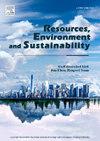Global supply chain restructuring towards achieving a low-carbon procurement of mineral resources for metal production
IF 12.4
Q1 ENVIRONMENTAL SCIENCES
引用次数: 0
Abstract
To reduce embodied CO2 emissions in producing metals for which rapid demand growth is expected due to their critical role in decarbonization, it is essential for metal industries worldwide to establish a low-carbon procurement structure of mineral resources as raw materials for their production activities. This study explored the CO2 reduction potential by shifting the sourcing partners of mineral resources for metal production towards a low-carbon procurement structure, considering the structural changes in global supply chains (GSCs) (i.e., GSC restructuring) triggered by these shifts. In this process, we applied a multi-regional input output framework in an extended way to model the GSC restructuring based on physical transactions of mineral resources internationally traded in GSCs. From the results focusing on the restructuring of GSCs of the Japanese industries towards the low-carbon procurement of iron and copper ores revealed a CO2 reduction potential of the GSC restructuring by approximately -40% of CO2 emissions embodied in the production of both relevant mineral resources induced in the GSCs. Furthermore, by comparing the restructuring in GSCs of the Japanese, German, USA, and Chinese industries, we highlighted differences in the significance of the CO2 reduction potential of GSC restructuring in each GSC. Finally, we demonstrated the GSC restructuring formulated in this study has a large contribution to reducing scope3-CO2 emissions of metal production in the relevant GSCs, and provided effective policy suggestions for governments in countries that rely on outsourcing for mineral resources based on our findings.

全球供应链重组,实现金属生产矿产资源的低碳采购
由于金属在脱碳中的关键作用,预计金属的需求将迅速增长,为了减少金属生产过程中的隐含二氧化碳排放,世界各地的金属工业必须建立一种低碳采购结构,将矿产资源作为其生产活动的原材料。考虑到全球供应链(GSC)的结构变化(即GSC重组),本研究探讨了通过将金属生产矿产资源的采购伙伴转向低碳采购结构来减少二氧化碳的潜力。在此过程中,我们以扩展的方式应用了一个多区域投入产出框架,以GSC国际贸易中矿产资源的实物交易为基础,对GSC重组进行了建模。从聚焦于日本产业GSC向低碳采购铁矿石和铜矿转型的结果来看,GSC重组的二氧化碳减排潜力约为GSC中相关矿产资源生产中二氧化碳排放量的-40%。此外,通过比较日本、德国、美国和中国的GSC结构调整,我们突出了各GSC结构调整的CO2减排潜力的显著性差异。最后,我们论证了本文制定的GSC结构调整对减少相关GSC金属生产的范围3- co2排放有很大的贡献,并基于我们的研究结果为依赖矿产资源外包的国家的政府提供了有效的政策建议。
本文章由计算机程序翻译,如有差异,请以英文原文为准。
求助全文
约1分钟内获得全文
求助全文
来源期刊

Resources Environment and Sustainability
Environmental Science-Environmental Science (miscellaneous)
CiteScore
15.10
自引率
0.00%
发文量
41
审稿时长
33 days
 求助内容:
求助内容: 应助结果提醒方式:
应助结果提醒方式:


